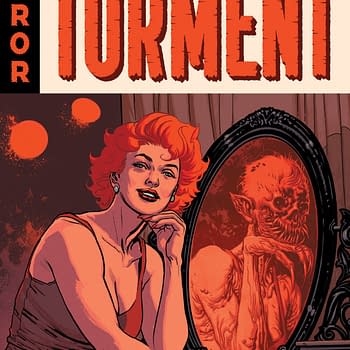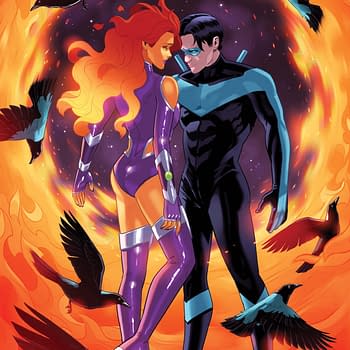Posted in: Comics, Recent Updates | Tagged: batman 1, christopher nolan, Comics, conrad veidt, entertainment, heath ledger, jerry robinson, The Joker, the man who laughs, victor hugo
Want to Know How I Got These Scars? Victor Hugo and the Early Origins of the Joker
By Ryan Michael
At first I found it difficult to decide how to open this article. The title may offer a hint, but really, how do you talk about a character that's crept around countless forms of literature for almost 75 years, and still manage to bring something original to the table? If I traced The Joker's history back to his creation in 1940, I could tell you a story about the late Jerry Robinson's sick brainchild. Perhaps not the most inspiriting adjective—the character does remain ever-popular—but that's exactly what he was, sick.
The Joker of 1940 wasn't funny. He was a murderer who took the lives of innocent people, a lot of them—his motives fueled by greed, a thirst for collecting and worse, simply because he could. The days of the archetypal bank robber rendered obsolete, the advent of the Joker was something worse, or better, depending on your perspective. These stories weren't appropriate for children, ever. The Joker's debut in Batman #1 (Spring 1940) saw him kill no less than four people in the story's first eight pages. It's a bit disturbing, sitting back now to think that these stories were sold to kids for ten-cents—Frederic Wertham would have had a field day.
Violence was commonplace in comics, but this was new, the psychological aspect of it at least. The Joker didn't just kill to be branded the bad guy, there was ego involved and it was a lot deeper than the conventional "I'm not gonna let him mess with me" complex. 74 years ago this April, the Joker killed his first victim—issuing his threat publicly over the radio.
Tonight. At precisely twelve o'clock midnight, I will kill Henry Claridge and steal the Claridge diamond! Do not try to stop me! The Joker has spoken!" -The Joker (Batman #1)
Twenty four hours before his death, the Joker snuck into Claridge's home and injected him with a chemical-solution as he slept. He stole the famous Claridge diamond, replaced it with a fake, and left it's owner to die unknowingly—exactly twenty four hours later. He could have ended his life by any number of traditional means: gun shot, stabbing, strangulation, suffocation—only the Joker wanted more. His radio proclamation foretold of a murder that couldn't be stopped and a theft that had already been committed.
The Claridge diamond mine! Bungling police — how they would like to know how I managed it! And how I should like to shout the answer into their stupid faces! A solution injected into sleeping Claridge at twelve last night. A solution that kills in exactly twenty four hours, so that he died at twelve tonight! They find the glass diamond tonight that I exchanged for the real one last night! A prediction on the radio of a crime that has already been done!" -The Joker (Batman #1)
This character was something different entirely. It's no surprise than that Christopher Nolan and Heath Ledger used the two Joker stories found in Batman #1 as inspiration to help derive their own interpretation of the character. Just as Robinson had done in 1940, Ledger's Joker was a man clouded with more mystery than explanation. His motive, if he had any at all, was to be without motive—a living contradiction.
Want to know how I got these scars? -Heath Ledger
Ledger wasn't smiling like the clowns that came before him. His face was disfigured, something he felt every time he licked his gums, every time his facial muscles contracted—Ledger's Joker always appeared uncomfortable when smiling.
Only his scars didn't come from his abusive father, nor did they come from self-mutilation as the film implied. They actually came, indirectly perhaps, from Victor Hugo—the famous french novelist. Known best for penning masterpieces the likes of Les Misérables and The Hunchback of Notre-Dame, Hugo wrote a much darker novel in 1869 titled The Man Who Laughs.
Before there was a Joker, there was Gwynplaine—a boy whose face was intentionally disfigured, leaving him permanently scarred with a ghastly grin. He wasn't a villain. He'd actually grow up to become a hero, but his striking visuals still left an impression. When the novel was adapted to silent film in 1928, Conrad Veidt was cast as the leading role—fitted with a mouth-piece to perpetually maintain his smile. That very same silent film served as the visual inspiration for the character when he was first created in 1940.
When Nolan introduced the Joker into his Batman universe, He looked backward in an effort to help progress the character forward. The vat of chemicals, the bleached-white skin—that was out. Ledger's Joker would possess Gwynplain's Glasgow smile, hidden beneath war paint. Only If you hadn't read The Man Who Laughs, you wouldn't know that.
In 2012, a french film adaptation of the novel was released, titled L'Homme Qui Rit. Makeup had advanced considerably since the 1928, and this time, Gwynplaine's disfigured smile was there for the world to see—scars included. The inspiration for the makeup used in this film? None other than Heath Ledger's Joker.
The connections between Gwynplaine and the Joker don't end there—more specifically, pertaining to Veidt and Ledger. While researching the lives of both actors, I stumbled across some eerie info.
Ledger was born on April 4th, 1979—36 years and a few hours to the the day Veidt died (April 3rd, 1943).
It gets creepier. Veidt was born on January 22nd, 1893—115 years to the day Ledger died (January 22nd, 2008).
Conrad Veidt: Born January 22nd, 1893 Died April 3rd, 1943
Heath Ledger: Born April 4th, 1979 Died January 22nd, 2008
The odds of both men being born on one another's date of passing, then dying on each other's birthday's: 1 in 133,225.
That stopped me in my tracks right there.
Ryan Michael is a writer, researcher, Golden Age comic book enthusiast and superhero film critic.



















